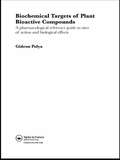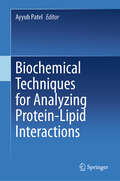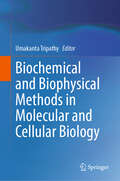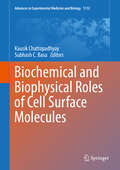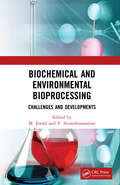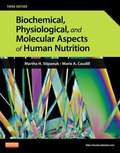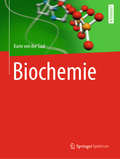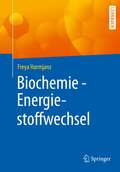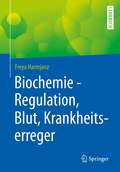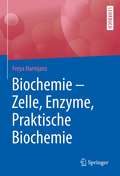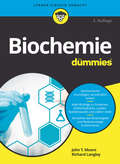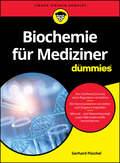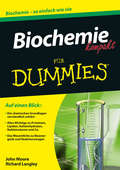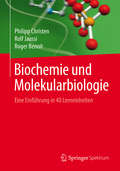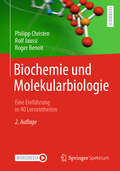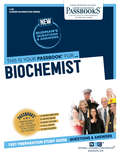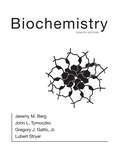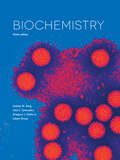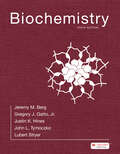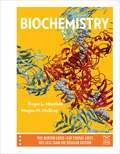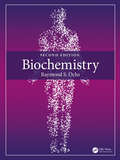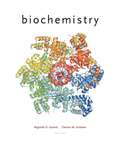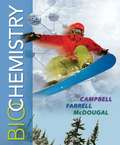- Table View
- List View
Biochemical Targets of Plant Bioactive Compounds: A Pharmacological Reference Guide to Sites of Action and Biological Effects
by Gideon PolyaWhen introduced to the human body, bioactive metabolites produced by plants for self defense bind to particular biochemical targets, most notably to proteins involved in signaling by hormones and neurotransmitters. This, essentially, is the basis for the effects of herbal medicine. While herbal medicine preparations may act by complex synergistic i
Biochemical Techniques for Analyzing Protein-Lipid Interactions
by Ayyub PatelThe book reviews cutting-edge advancements and their implications across various domains of molecular diagnostics. It covers foundational topics like protein-ligand interactions, lipid-protein interactions within biological membranes, and the application of NMR spectroscopy in understanding membrane structures. The book also explores advanced techniques such as X-ray crystallography, liposome microarray assays, and protein-lipid interaction studies. By integrating experimental and computational methods, it provides a comprehensive guide to understanding the complexities of molecular diagnostics, from basic principles to innovative approaches in drug discovery and therapeutic development. Each chapter offers detailed discussions on specific topics, supported by experimental data and methodological insights, making it an invaluable resource for researchers, clinicians, and students seeking to enhance their knowledge and expertise in molecular diagnostics.
Biochemical and Biophysical Methods in Molecular and Cellular Biology
by Umakanta TripathyThis book focuses on the fundamental principles and applications of several modern biochemical and biophysical techniques employed in molecular and cellular biology. It describes cutting-edge techniques for studying single molecules/biomolecules, subcellular structures, and cells. The book chapters provide an in-depth understanding of methods currently employed to visualize and probe molecular and cellular processes. The techniques discussed in this book include Mass spectrometry, Microscopy techniques, Forster resonance energy transfer (FRET), Z-scan, Fluorescence correlation and cross-correlation spectroscopy, Dynamic light scattering (DLS), X-ray crystallography, Total internal reflection fluorescence (TIRF) microscopy, Cryo-EM, NMR spectroscopy, Optical tweezers, Magnetic tweezers, Raman spectroscopy, Atomic force microscopy (AFM), Optogenetics, bioinformatics, etc. The book chapters also include the biomedical, industrial, and R&D applications of these methods. Also included are sections on data analysis and its interpretation. Overall, this book offers a comprehensive and detailed understanding of several modern techniques in molecular and cellular biology.
Biochemical and Biophysical Roles of Cell Surface Molecules (Advances in Experimental Medicine and Biology #1112)
by Subhash C. Basu Kausik ChattopadhyayCell surface small molecules and macromolecules, such as members of cholesterol family (including steroid hormones), the glycolipid family (sphingolipids), the glycoprotein family (both N-linked and O-linked), and a vast array of other receptors have been shown to be involved in normal and abnormal cellular processes. The 11th International Symposium on Cell Surface Macromolecules, held in Mohali, India, in February 2017 provided a comprehensive update on the major advances in this area. Presenting selected contributions from this meeting, this book comprises 24 chapters, which provide in-depth analyses of data on the role of cell surface macromolecules in cellular function and their alterations associated with pathological conditions. It includes comprehensive research papers and critical overviews of the functional role of cell surface molecules, discussing topics such as biochemical, biophysical, and cell biological approaches to study cell membrane molecules, and metabolism of glycoconjugates.
Biochemical and Environmental Bioprocessing: Challenges and Developments
by V. Sivasubramanian M. JeroldThe rapid growth of industries has resulted in the generation of high volume of solid and liquid waste. Today, there is a need of Clean and Green technology for the sustainable waste management. Biochemical and Environmental Bioprocessing: Challenges and Developments explore the State-of-art green technologies to manage the waste and to recover value added products. Microbes play an important role in the bioremediation. Bioprocess engineering an interdisciplinary connects the Science and Technology. The bioconversion and bioremediation is essentially required for the management of various hazardous substances in the environment. This book will give an intensive knowledge on the application of Biochemical and Bioprocess technologies for the eco-friendly management of pollution. This book serves as a fundamental to the students, researchers, academicians and Engineers working in the area of Environmental Bioremediation and in the exploration of various bioproducts from waste. Features Reviews various biological methods for the treatment of effluents from Industries by using biomass and biopolymers. Highlights the applications of various bioreactors like Anaerobic Sequential Batch Reactor, Continuously stirred anaerobic digester, Up-flow anaerobic sludge blanket reactor, Fluidized and expanded bed reactors. Presents the cultivation of algae in Open Pond, Closed loop System, and Photo-bioreactors for bioenergy production. Discusses the intensified and integrated biorefinery approach by Microwave Irradiation, Pyrolysis, Acoustic cavitation, Hydrodynamic cavitation, Electron beam irradiation, High pressure Autoclave reactor, Steam explosion and photochemical oxidation. Outlines the usage of microbial fuel cell (MFC) for the production bioelectricity generation in different modules Tubular MFC, Stacked MFC, Separate electrode modules Cutting edge research of synthesis of biogenic nanoparticles and Pigments by green route for the health care and environment management.
Biochemical, Immunological and Epidemiological Analysis of Parasitic Diseases
by P.K. Bandyopadhyay N.R. Das Amit ChattopadhyayThis book comprehensively reviews various vector-borne diseases and their control methods. It discusses morphology, life history, and pathogenicity of protozoan and helminth parasites. Further, it analyzes host-parasite interactions and their adaptation within the host system for understanding parasitic infections. The book discusses the complex life cycle, biochemical adaptations, and molecular biology of the parasites. It investigates the immunological response to different infectious agents and explores new targets for combined therapeutic approaches. It also summarizes the evolution of parasitism and the ecology of parasites of the different phylum. Lastly, it provides information on vector biology emphasizing the role of basic vector research in developing future disease control methods and improving upon the existing approaches.
Biochemical, Physiological, And Molecular Aspects of Human Nutrition
by Martha H. Stipanuk Marie A. CaudillCovering advanced nutrition with a comprehensive, easy-to-understand approach, Biochemical, Physiological, and Molecular Aspects of Human Nutrition, 3rd Edition focuses on the biology of human nutrition at the molecular, cellular, tissue, and whole-body levels. It addresses nutrients by classification, and describes macronutrient function from digestion to metabolism. This edition includes the new MyPlate dietary guide and recommendations from the Dietary Guidelines for Americans 2010, plus coverage of the historical evolution of nutrition and information on a wide range of vitamins, minerals, and other food components. In Biochemical, Physiological, and Molecular Aspects of Human Nutrition, lead authors Martha H. Stipanuk and Marie A. Caudill are joined by a team of nutrition experts in providing clear, concise, coverage of advanced nutrition.
Biochemie
by Karin von der SaalVerständlich und kompakt, gibt Ihnen dieses kurze Lehrbuch einen Überblick zu den wichtigsten Themen der Biochemie. Dabei lernen Sie die großen Zusammenhänge kennen, gewinnen aber auch interessante Einblicke, zum Beispiel zu Ernährungs- und medizinischen Themen, die den Stoff in einen breiteren Zusammenhang stellen. Dieses Buch ist für Sie richtig, wenn Sie Biochemie studieren und sich auf die Bachelor-Prüfung vorbereiten; Sie bekommen hier ein Repetitorium in die Hand. andere naturwissenschaftliche Fächer studieren oder Quereinsteiger sind; Sie erhalten hier einen Einblick in die Biochemie.Laborant/in, Techniker/in oder Ingenieur/in sind, Ihr Wissen auffrischen möchten oder Grundkenntnisse der Biochemie für ihren Beruf benötigen. Mit umfangreichen Querbezügen zum beliebtesten großen Biochemie-Lehrbuch, dem „Stryer“, können Sie den hier dargestellten Stoff bei Bedarf sofort vertiefen.
Biochemie - Energiestoffwechsel
by Freya HarmjanzWenn Sie die Biochemie im Großen und Ganzen verstehen wollen, ohne Unmengen von Details auswendig zu lernen, sind Sie hier richtig. In diesem Buch beginnt jedes Kapitel mit einer verständlichen Abbildung für den Überblick, bevor es in die Tiefe geht. So laufen Sie nicht Gefahr, den Überblick zu verlieren.Bei der Erklärung der vielen Moleküle werden die Zusammenhänge innerhalt der Biochemie dargestellt und dabei die drei wichtigen Fragen beantwortet:· Woher kommt das Molekül?· Was macht es hier?· Wo geht es danach hin?Und für die Klinik gibt es Antwort auf die spannende Frage:· Was passiert eigentlich, wenn hier was schief geht?Da die Semesterklausuren häufig schwieriger sind als das Examen, legt das Buch seinen Schwerpunkt auf die Klausuren. So sind Sie für alle Fälle gut gerüstet. Und damit die Biochemie handlich bleibt, ist der Stoff auf drei Bände verteilt:Band 1 Zelle, Enzyme und praktische BiochemieBand 2 EnergiestoffwechselBand 3 Regulation, Blut, Krankheitserreger
Biochemie - Regulation, Blut, Krankheitserreger
by Freya HarmjanzWenn Sie die Biochemie im Großen und Ganzen verstehen wollen, ohne Unmengen von Details auswendig zu lernen, sind Sie hier richtig. In diesem Buch beginnt jedes Kapitel mit einer verständlichen Abbildung für den Überblick, bevor es in die Tiefe geht. So laufen Sie nicht Gefahr, den Überblick zu verlieren.Bei der Erklärung der vielen Moleküle werden die Zusammenhänge innerhalb der Biochemie dargestellt und dabei die drei wichtigen Fragen beantwortet:· Woher kommt das Molekül?· Was macht es hier?· Wo geht es danach hin?Und für die Klinik gibt es Antwort auf die spannende Frage:· Was passiert eigentlich, wenn hier was schief geht?Da die Semesterklausuren häufig schwieriger sind als das Examen, legt das Buch seinen Schwerpunkt auf die Klausuren. So sind Sie für alle Fälle gut gerüstet. Und damit die Biochemie handlich bleibt, ist der Stoff auf drei Bücher verteilt:Zelle, Enzyme und praktische BiochemieEnergiestoffwechselRegulation, Blut, Krankheitserreger
Biochemie - Zelle, Enzyme, Praktische Biochemie
by Freya HarmjanzWenn Sie die Biochemie im Großen und Ganzen verstehen wollen, ohne Unmengen von Details auswendig zu lernen, sind Sie hier richtig. In diesem Buch beginnt jedes Kapitel mit einer verständlichen Abbildung für den Überblick, bevor es in die Tiefe geht. So laufen Sie nicht Gefahr, den Überblick zu verlieren. Bei der Erklärung der vielen Moleküle werden die Zusammenhänge innerhalt der Biochemie dargestellt und dabei die drei wichtigen Fragen beantwortet: · Woher kommt das Molekül?· Was macht es hier?· Wo geht es danach hin? Und für die Klinik gibt es Antwort auf die spannende Frage: · Was passiert eigentlich, wenn hier was schief geht? Da die Semesterklausuren häufig schwieriger sind als das Examen, legt das Buch seinen Schwerpunkt auf die Klausuren. So sind Sie für alle Fälle gut gerüstet. Und damit die Biochemie handlich bleibt, ist der Stoff auf drei Bände verteilt: Band 1 Zelle, Enzyme und praktische Biochemie Band 2 Energiestoffwechsel Band 3 Regulation, Blut, Krankheitserreger
Biochemie für Dummies (Für Dummies)
by John T. Moore Richard H. LangleyHaben Sie Ihre liebe Mühe mit der Biochemie? Diese ganzen Formeln und Reaktionen sind überhaupt nicht Ihr Ding? Die nächste Prüfung steht vor der Tür? Kein Problem! In diesem Buch erklärt der Autor Ihnen, was Sie über Biochemie wissen müssen. Er führt Sie so einfach wie möglich und so komplex wie nötig in die Welt der Kohlenhydrate, Lipide, Proteine, Nukleinsäuren, Vitamine, Hormone und Co. ein. So leicht kann Biochemie sein.
Biochemie für Mediziner für Dummies (Für Dummies)
by Gerhard PüschelIhr Wegweiser durch den Dschungel der Biochemie Sie müssen eine Biochemie-Prüfung bestehen und Biochemie erscheint Ihnen so unanschaulich und schwer verständlich, das absolute Horrorfach? In diesem Buch werden biochemische Grundlagen und Zusammenhänge leicht verständlich erklärt. Über 300 speziell für dieses Buch entworfene Abbildungen und Schemata machen den Stoff anschaulicher und helfen Ihnen, den Durchblick zu bekommen. Gerhard Püschel erklärt Ihnen Stoffwechselwege und deren Regulation, Kommunikation zwischen Zellen und Organen, Zellzykluskontrolle und vieles mehr auf wissenschaftlich aktuellem Stand, aber »gut verdaulich«, damit das Lernen auch ein wenig Spaß macht. Sie erfahren Was Sie über Kohlenhydrat-, Lipid- und Proteinstoffwechsel wissen sollten Welche Funktion Vitamine und Spurenelemente haben Wie Replikation, Transkription, Translation und Kontrolle der Genexpression funktionieren Wie Hormone, Cytokine und deren Rezeptoren Zell- und Organfunktion steuern
Biochemie kompakt für Dummies (Für Dummies)
by John T. Moore Richard H. LangleyDer schnelle Überblick für Schüler, Studenten und jeden, den es sonst noch interessiert Stehen Sie auf Kriegsfuß mit der Biochemie? Diese ganzen Formeln und Reaktionen sind überhaupt nicht Ihr Ding, aber die nächste Prüfung steht vor der Tür? Kein Problem! Biochemie kompakt für Dummies erklärt Ihnen das Wichtigste, was Sie über Biochemie wissen müssen. Sie warden so einfach wie möglich und so komplex wie nötig in die Welt der Kohlenhydrate, Lipide, Proteine, Nukleinsäuren, Vitamine, Hormone und Co. eingeführt. So leicht und kompakt kann Biochemie sein.
Biochemie kompakt für Dummies (Für Dummies)
by John T. Moore Richard H. LangleyStehen Sie auf Kriegsfuß mit der Biochemie? Diese ganzen Formeln und Reaktionen sind überhaupt nicht Ihr Ding? Die nächste Prüfung steht vor der Tür? Kein Problem! "Biochemie kompakt für Dummies" erklärt Ihnen das Wichtigste, was Sie über Biochemie wissen müssen. Sie werden so einfach wie möglich und so komplex wie nötig in die Welt der Kohlenhydrate, Lipide, Proteine, Nukleinsäuren, Vitamine, Hormone und Co. eingeführt. So leicht und kompakt kann Biochemie sein.
Biochemie und Molekularbiologie: Eine Einführung in 40 Lerneinheiten
by Philipp Christen Rolf Jaussi Roger BenoitDiese Einf#65533;hrung in die Biochemie und Molekularbiologie ist f#65533;r alle geschrieben, die sich f#65533;r die molekularen Aspekte der Lebensvorg#65533;nge interessieren, insbesondere f#65533;r Studierende der Medizin und der Naturwissenschaften, denen die Biochemie als Grundlagenwissenschaft dient. Die 40 kurzen Kapitel k#65533;nnen weitgehend unabh#65533;ngig voneinander benutzt werden. Mit seinem hohen Bildanteil setzt das Buch auf visuelles Lernen. Zu jedem Kapitel gibt es eine ausf#65533;hrliche, kommentierte Linksammlung, die u. a. Bildmaterial, Animationen, Datenbanken sowie Merks#65533;tze und Kontrollfragen enth#65533;lt. Die Inhalte der Website k#65533;nnen #65533;ber QR-Codes im Buch, aber auch #65533;ber die Webadresse abgerufen werden. Das Lehrbuch basiert auf dem 2005 von den Autoren ver#65533;ffentlichten Titel Biochemie. Der Text ist korrigiert, erg#65533;nzt und gestrafft worden.
Biochemie und Molekularbiologie: Eine Einführung in 40 Lerneinheiten
by Philipp Christen Rolf Jaussi Roger BenoitDiese Einführung in die Biochemie und Molekularbiologie ist für alle geschrieben, die sich für die molekularen Aspekte der Lebensvorgänge interessieren, insbesondere für Studierende der Medizin und der Naturwissenschaften, denen die Biochemie als Grundlagenwissenschaft dient. Die 40 kurzen Kapitel können weitgehend unabhängig voneinander benutzt werden. Mit seinem hohen Bildanteil setzt das Buch auf visuelles Lernen. Über eine das Buch ergänzende Website erhalten Sie Zugang zur ausführlichen, kommentierten Linksammlung, die u.a. Bildmaterial, Animationen, Datenbanken sowie Merksätze und Kontrollfragen für jedes einzelne Kapitel enthält. Für die Neuauflage haben die Autoren den Text überarbeitet und aktualisiert; im Methodenteil ist die Beschreibung der bildgebenden Verfahren ausgebaut worden.
Biochemist: Passbooks Study Guide (Career Examination Series)
by National Learning CorporationThe Biochemist Passbook® prepares you for your test by allowing you to take practice exams in the subjects you need to study. It provides hundreds of questions and answers in the areas that will likely be covered on your upcoming exam, including but not limited to: principles of biochemistry; practices of biochemisty; methods of biochemistry; and other related areas.
Biochemistry
by Jr. John L. Tymoczko Jeremy M. Berg Lubert Stryer Gregory J. GattoFor four decades, this extraordinary textbook played an pivotal role in the way biochemistry is taught, offering exceptionally clear writing, innovative graphics, coverage of the latest research techniques and advances, and a signature emphasis on physiological and medical relevance. Those defining features are at the heart of this edition. See what's in the LaunchPad
Biochemistry
by John L. Tymoczko Jeremy M. Berg Lubert Stryer Gregory J. Gatto Jr.Digital innovation and trusted authorship transform the way biochemistry students learn. For four decades, this extraordinary textbook played a pivotal role in the way biochemistry is taught, offering exceptionally clear writing, innovative graphics, coverage of the latest research techniques and advances, and a signature emphasis on physiological and medical relevance. Those defining features are at the heart of this edition.Biochemistry is now supported in Achieve, Macmillan’s new online learning platform, Achieve is the culmination of years of development work put toward creating the most powerful online learning tool for chemistry students. Achieve includes an interactive e-Book as well as our renowned assessments and a variety of multimedia assets. Instructors can assign or download instructor resources and take advantage of powerful analytics and quick insights to inform teaching.
Biochemistry
by John L. Tymoczko Jeremy M. Berg Lubert Stryer Gregory J. Gatto, Jr. Justin HinesAccompanied by a wide range of interactive features, the new edition of Biochemistry is an invaluable resource for your academic and professional careers.
Biochemistry
by Roger L. Miesfeld Megan M. McEvoyBiochemistry promotes understanding of biochemical concepts through highly readable chapters that consistently integrate stunning graphics with text. Its distinctive table of contents highlights how biochemical processes work, and applications to everyday biochemistry ensure that students develop a complete understanding of why biochemistry matters.
Biochemistry
by Raymond S. OchsBiochemistry Second Edition, is a single-semester text designed for undergraduate non-biochemistry majors. Accessible, engaging, and informative, it is the perfect introduction to the subject for students who may approach chemistry with apprehension. Its unique emphasis on metabolism and its kinetic underpinnings gives the text up-to-the-minute relevance for students investigating current public health concerns, such as obesity and diabetes. Biochemistry Second Edition will encourage students to explore the basics of chemistry and its influence on biological problems. Key Features: Provides an understanding of (mostly) enzymatic reactions that are responsible for the function and maintenance of living things. This innovative text for non-biochemistry majors includes introductory material at the beginning of each chapter that contextualizes chapter themes in real-life scenarios. Online supporting materials with further opportunities for research and investigation. Synthesis questions at the end of each chapter that encourage students to make connections between concepts and ideas, as well as develop critical-thinking skills. About the Author: Raymond S. Ochs is a biochemist with a career-long specialty in metabolism spanning 30 years. Previously, he has written the textbook Biochemistry, contributed the metabolism chapters to another text, Principles of Biochemistry, and co-edited a collection of articles published as Metabolic Regulation, and the recent monograph Metabolic Strucure and Regulation. His research interests concern major pathways of liver and muscle, including glycolysis, gluconeogenesis, ureogenesis, fatty acid metabolism, glycogen metabolism, and control by cAMP, Ca2+, diacylglycerol, and AMPK. He is currently professor of pharmacy at St. John’s University in New York, teaching biochemistry, physiology, and medicinal chemistry.
Biochemistry (6th Edition)
by Reginald H. Garrett Charles M. GrishamContinuing Garrett and Grisham's innovative conceptual and organizing Essential Questions framework, BIOCHEMISTRY guides students through course concepts in a way that reveals the beauty and usefulness of biochemistry in the everyday world. Offering a balanced and streamlined presentation, this edition has been updated throughout with new material and revised presentations. For the first time, this book is integrated with OWL, a powerful online learning system for chemistry with book-specific end-of-chapter material that engages students and improves learning outcomes.
Biochemistry (Ninth Edition)
by Mary Campbell Shawn Farrell Owen M. McDougalIdeal for those studying biochemistry for the first time, this proven book balances scientific detail with readability and shows you how principles of biochemistry affect your everyday life. Designed throughout to help you succeed (and excel!), the book includes in-text questions that help you master key concepts, end-of-chapter problem sets grouped by problem type that help you prepare for exams, and state-of-the art visuals that help you understand key processes and concepts. In addition, visually dynamic Hot Topics cover the latest advances in the field, while Biochemical Connections demonstrate how biochemistry affects other fields, such as health and sports medicine.
